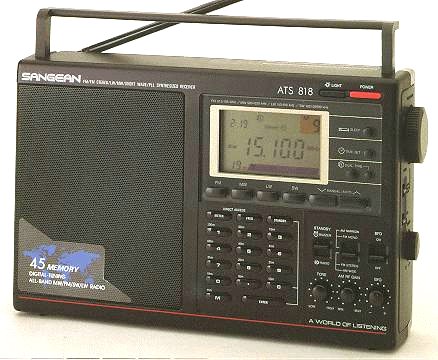
Year Introduced: 1993
Power: 6 Volts DC, AC adaptor optional & 4.5 Volts DC (3 AA) batteries back-up
Size: 17.8 x 28.5 x 6.4 cm
Weight: 1800 g without batteries (cassette version is heavier; 2000 g) Prices: ATS-818 US$140, CAN$250, £160, A$350, €300.
ATS-818ACS US$200, CAN$280.
DX-390 US$220, CAN$300.
DX-392 US$260, CAN$350.
Coverage: AM, SW (continuous 150 kHz-30 MHz), FM
Value Rating: 



This review was compiled independently. The Medium Wave Circle and Radio Netherlands has no financial connection with Sangean, the manufacturer of this receiver.
INTRODUCTION
Sangean markets two models of the portable. The ATS-818 has a larger speaker than the ATS-818CS that includes a programmable cassette recorder. These are also marketed by Radio Shack as the DX-390 and DX-392 respectively. The ATS-818ACS model was also sold as the Siemens RK-670 until Seimens stopped importing receivers in mid-1996.
The ATS-818ACS is designed as a table-top receiver. You can either operate the set upright, which makes the buttons for the cassette recorder easy to operate, or unclasp a stand on the rear of the set. This lets you tilt the front panel at 45 degrees, making the radio operation much easier. A total of seven batteries are needed. Three penlights are used to run the clock and computer section of the radio. An additional four “D” size cells are needed to power the radio itself. Power consumption at an average listening volume is 80 mA. Switch on the cassette recorder and the consumption rises to 150 mA.
If the radio is playing, and recording to the cassette at the same time, power consumption is in the region of 200 mA. We obtained a battery of life of 7 hours with cassette and radio playing simultaneously, before the four alkaline “D” cells needed replacing. When this happens, there is a noticeable increase in distortion, and a letter “E” is displayed. So it makes sound economic sense to use the 6 V DC mains adapter that is supplied.
TUNING
The radio has a keypad for direct frequency entry. You push a button marked frequency and tap in the desired channel. The software is clever… “9890” is recognised as a shortwave channel, where as “98.90” is regarded as FM. There’s a simple button sequence to find the lower end of each of the shortwave bands.
Manual tuning is achieved in two ways. “UP” and “DOWN” buttons allow you “jump” to the next channel. On shortwave the steps are 5 kHz apart. On medium/longwave the steps are 9 kHz apart, but unfortunately the steps do not correspond with the new longwave plan for Europe. The set jumps to 200 kHz for BBC Radio 4, when in fact the station is on 198 kHz. If you depress either of the UP-DOWN buttons for more than a few seconds the radio starts to scan, stopping when it hits a strong signal.
A tuning control on the side of the set can either be set to do exactly the same as the “UP-DOWN” buttons, or set to a “FINE” position. This allows tuning in 1 kHz steps on LW, MW, and SW, 50 kHz on FM. The receiver can receive single-sideband signals thanks to a beat frequency oscillator. A small rotary knob is used to clarify the signal… not as easy as with sets those have USB or LSB selection.
PERFORMANCE
The ATS-818 is sensitive enough on all the bands, although in low signal strength areas, a piece of long wire clipped to the antenna may be needed for the reception of signals higher than 15 MHz. The dual conversion receiver offers two bandwidth filters (6/2.8 kHz @ -6 dB) for AM/SSB reception. The shape factor of the filters is fair. Image rejection on medium wave was found to be mediocre, and on shortwave it is also only fair. The RF gain control didn’t seem to have much effect on reducing spurious signals, except to demand that you turn up the volume.
The inclusion of the cassette recorder means the speaker in the radio has been reduced in size. In fact there are two, one 2 cm tweeter and a 7 cm woofer. In general we found the audio to be somewhat muffled, this being especially noticeable when headphones are connected. Reception on FM, and cassette playback, is in stereo using headphones.
CASSETTE RECORDER
The stereo cassette recorder has a tape-type selector switch but no Dolby. The timer in the radio can be used to switch the recorder on at a pre-determined time to tape a programme unattended. The set has a built-in microphone, but you can only use it for logging notes. The background hum from the drive mechanism rules out any serious recordings.
CONCLUSIONS
The addition of a cassette recorder in the ATS-818CS version has compromised the sound quality of the radio, but the price is attractive for those who want an “all-in-one” unit. It is more than adequate for general programme listening, although the image rejection may create problems for those interested in digging the weaker stations out of the noise. Overall, we rate both versions as a good value buy.
This review first appeared on the Radio Netherlands website.